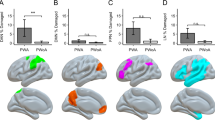Abstract
Right hemispheric stroke aphasia (RHSA) rarely occurs in right- or left-handed patients with their language representation in right hemisphere (RH). For right-handers, the term crossed aphasia is used. Single cases, multiple cases reports, and reviews suggest more variable anatomo-clinical correlations. We included retrospectively from our stroke data bank 16 patients (right- and left-handed, and ambidextrous) with aphasia after a single first-ever ischemic RH stroke. A control group was composed of 25 successive patients with left hemispheric stroke and aphasia (LHSA). For each patient, we analyzed four modalities of language (spontaneous fluency, naming, repetition, and comprehension) and recorded eventual impairment: (1) on admission (hyperacute) and (2) between day 3 and 14 (acute). Lesion volume and location as measured on computed tomography (CT) and magnetic resonance imaging (MRI) were transformed into Talairach stereotaxic space. Nonparametric statistics were used to compare impaired/nonimpaired patients. Comprehension and repetition were less frequently impaired after RHSA (respectively, 56% and 50%) than after LHSA (respectively, 84% and 80%, P = 0.05 and 0.04) only at hyperacute phase. Among RHSA, fewer left-handers/ambidextrous than right-handers had comprehension disorders at second evaluation (P = 0.013). Mean infarct size was similar in RHSA and LHSA with less posterior RHSA lesions (caudal to the posterior commissure). Comprehension and repetition impairments were more often associated with anterior lesions in RHSA (Fisher’s exact test, P < 0.05). Despite the small size of the cohort, our findings suggest increased atypical anatomo-functional correlations of RH language representation, particularly in non-right-handed patients.

Similar content being viewed by others
References
Alexander MP, Annett M (1996) Crossed aphasia and related anomalies of cerebral organization: case reports and a genetic hypothesis. Brain Lang 55(2):213–239
Alexander MP, Fischette MR, Fischer RS (1989) Crossed aphasias can be mirror image or anomalous. Case reports, review and hypothesis. Brain 112:953–973
Basso A, Lecours AR, Moraschini S, Vanier M (1985) Anatomoclinical correlations of the aphasias as defined through computerized tomography: exception. Brain Lang 26:201–229
Bütefisch CM, Kleiser R, Seitz RJ (2006) Post-lesional cerebral reorganisation: evidence from functional neuroimaging and transcranial magnetic stimulation. J Physiol Paris 99(4–6):437–454
Carr MS, Jacobson T, Boller F (1981) Crossed aphasia: analysis of four cases. Brain Lang 14:190–202
Croquelois A, Wintermark M, Reichhart M, Meuli R, Bogousslavsky J (2003) Aphasia in hyperacute stroke: language follows brain penumbra dynamics. Ann Neurol 54:321–329
Godefroy O, Dubois C, Debachy B, Leclerc M, Kreisler A (2002) Lille stroke program.Vascular aphasias: main characteristics of patients hospitalized in acute stroke units. Stroke 33:702–705
Habib M, Joanette Y, Ali-Cherif A, Poncet M (1983) Crossed aphasia in dextrals: a case report with special reference to site of lesion. Neuropsychologia 21(4):413–418
Hecaen H, Ajuriaguerra J (1963) Les gauchers. Prévalence manuelle et dominance cérébrale. Presses Universitaires de France, Paris
Hécaen H, Mazars G, Ramier AM, Goldblum MC, Mérienne L (1971) L’aphasie croisée chez un sujet bilingue (vietnamien–français). Rev Neurol 124:319–323
Hillis AE, Newhart M, Heidler J, Barker PB, Herskovits EH, Degaonkar M (2005) Anatomy of spatial attention: insights from perfusion imaging and hemispatial neglect in acute stroke. J Neurosci 23:3161–3167
Joanette Y (1989) Aphasia in left-handers and crossed aphasia. In: Boller F, Grafman J (eds) Handbook of neuropsychology, vol 2. Elsevier, Amsterdam, pp 173–183
Joanette Y, Puel M, Nespoulous JL, Rascol A, Lecours AR (1982) Aphasie croisée chez les droitiers. Rev Neurol 138:575–586
Jörgens S, Kleiser R, Indefrey P, Seitz RJ (2007) Handedness and functional MRI-activation patterns in sentence processing. Neuroreport 18(13):1339–1343
Kenin M, Swisher LP (1972) A study of pattern of recovery in aphasia. Cortex 8(1):56–68
Khedr EM, Hamed E, Said A, Basahi J (2002) Handedness and language cerebral lateralization. Eur J Appl Physiol 87:469–473
Knecht S, Drager B, Deppe M, Bobe L, Lohmann H, Flöel A, Ringelstein EB, Henningsen H (2000) Handedness and hemispheric language dominance in healthy humans. Brain 123:2512–2518
Kreisler A, Godefroy O, Delmaire C, Debachy B, Leclercq M, Pruvo JP, Leys D (2000) The anatomy of aphasia revisited. Neurology 54(5):1117–1123
Marien P, Engelborghs S, Vignolo LA, De Deyn PP (2001) The many faces of crossed aphasia in dextrals: report of nine cases and review of the literature. Eur J Neurol 8:643–658
Marien P, Paghera B, De Deyn PP, Vignolo LA (2004) Adult crossed aphasia in dextrals revisited. Cortex 40:41–74
Mazaux JM, Orgogozo JM (1982) Echelle d’évaluation de l’aphasie adaptée du Boston diagnostic aphasia examination. EAP Editions Psychotechniques, Paris
Mazzocchi F, Vignolo LA (1979) Localisation of lesions in aphasia: clinical-CT scan correlations in stroke patients. Cortex 15:627–654
Nespoulous JL, Lecours AR, Lafond D, Joanette Y, Lemay A, Puel M, Cot F, Rascol A (1992) Protocole Montréal-Toulouse d’examen linguistique de l’aphasie, MT 86, Module standard initial. Ortho Editions, Montréal
Oldfiedl RC (1971) The assessment and analysis of handedness: the Edinburgh inventory. Neuropsychologia 9:97–113
Pedersen PM, Vinter K, Olsen TS (2004) Aphasia after stroke: type, severity and prognosis. The Copenhagen aphasia study. Cerebrovasc Dis 17:35–43
Stone SP, Wilson B, Wroot A, Halligan PW, Lange LS, Marshall JC, Greenwood RJ (1991) The assessment of visuo-spatial neglect after acute stroke. J Neurol Neurosurg Psychiatry 54:345–350
Talairach J, Tournoux P (1988) Co-planar stereotaxic atlas of the human brain. Thieme, New York
Vignolo LA (1964) Evolution of aphasia and language rehabilitation: a retrospective exploratory study. Cortex 1:344–361
Author information
Authors and Affiliations
Corresponding author
Rights and permissions
About this article
Cite this article
Dewarrat, G.M., Annoni, JM., Fornari, E. et al. Acute aphasia after right hemisphere stroke. J Neurol 256, 1461–1467 (2009). https://doi.org/10.1007/s00415-009-5137-z
Received:
Revised:
Accepted:
Published:
Issue Date:
DOI: https://doi.org/10.1007/s00415-009-5137-z




